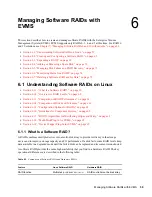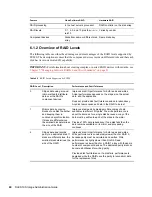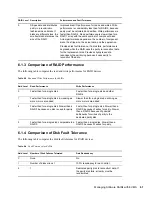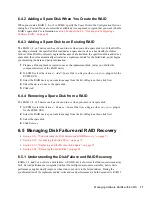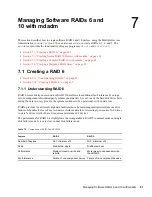
Managing Software RAIDs with EVMS
71
no
vd
ocx
(e
n)
6 Ap
ril 20
07
6.4.2 Adding a Spare Disk When You Create the RAID
When you create a RAID 1, 4, or 5 in EVMS, specify the
Spare Disk
in the
Configuration Options
dialog box. You can browse to select the available device, segment, or region that you want to be the
RAID’s spare disk. For information, see
Step 5d
in
Section 6.2, “Creating and Configuring a
Software RAID,” on page 65
.
6.4.3 Adding a Spare Disk to an Existing RAID
The RAID 1, 4, or 5 device can be active and in use when you add a spare disk to it. If the RAID is
operating normally, the specified disk is added as a spare and it acts as a hot standby for future
failures. If the RAID is currently degraded because of a failed disk, the specified disk is added as a
spare disk, then it is automatically activated as a replacement disk for the failed disk, and it begins
synchronizing the data and parity information.
1
Prepare a disk, segment, or region to use as the replacement disk, just as you did for the
component devices of the RAID device.
2
In EVMS, select the
Actions > Add > Spare Disk to a Region
(the
addspare
plug-in for the
EVMS GUI).
3
Select the RAID device you want to manage from the list of Regions, then click
Next
.
4
Select the device to use as the spare disk.
5
Click
Add
.
6.4.4 Removing a Spare Disk from a RAID
The RAID 1, 4, or 5 device can be active and in use when you remove its spare disk.
1
In EVMS, select the
Actions > Remove > Spare Disk from a Region
(the
remspare
plug-in
for the EVMS GUI).
2
Select the RAID device you want to manage from the list of Regions, then click
Next
.
3
Select the spare disk.
4
Click
Remove
.
6.5 Managing Disk Failure and RAID Recovery
Section 6.5.1, “Understanding the Disk Failure and RAID Recovery,” on page 71
Section 6.5.2, “Identifying the Failed Drive,” on page 72
Section 6.5.3, “Replacing a Failed Device with a Spare,” on page 73
Section 6.5.4, “Removing the Failed Disk,” on page 74
6.5.1 Understanding the Disk Failure and RAID Recovery
RAIDs 1, 4, and 5 can survive a disk failure. A RAID 1 device survives if all but one mirrored array
fails. Its read performance is degraded without the multiple data sources available, but its write
performance might actually improve when it does not write to the failed mirrors. During the
synchronization of the replacement disk, write and read performance are both degraded. A RAID 5
Summary of Contents for LINUX ENTERPRISE SERVER 10 - STORAGE ADMINISTRATION GUIDE 7-2007
Page 4: ...novdocx en 6 April 2007...
Page 30: ...30 SLES 10 Storage Administration Guide novdocx en 6 April 2007...
Page 42: ...42 SLES 10 Storage Administration Guide novdocx en 6 April 2007...
Page 58: ...58 SLES 10 Storage Administration Guide novdocx en 6 April 2007...
Page 90: ...90 SLES 10 Storage Administration Guide novdocx en 6 April 2007...
Page 100: ...100 SLES 10 Storage Administration Guide novdocx en 6 April 2007...
Page 106: ...106 SLES 10 Storage Administration Guide novdocx en 6 April 2007...



